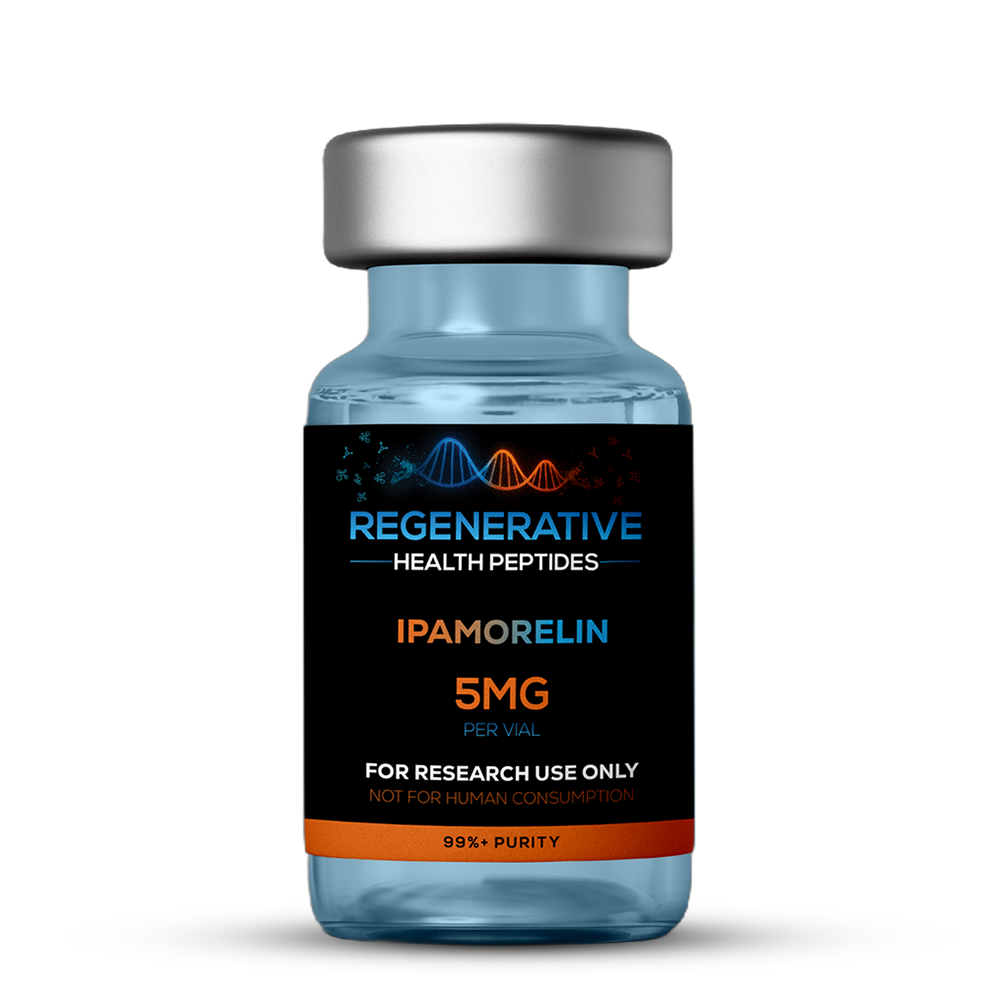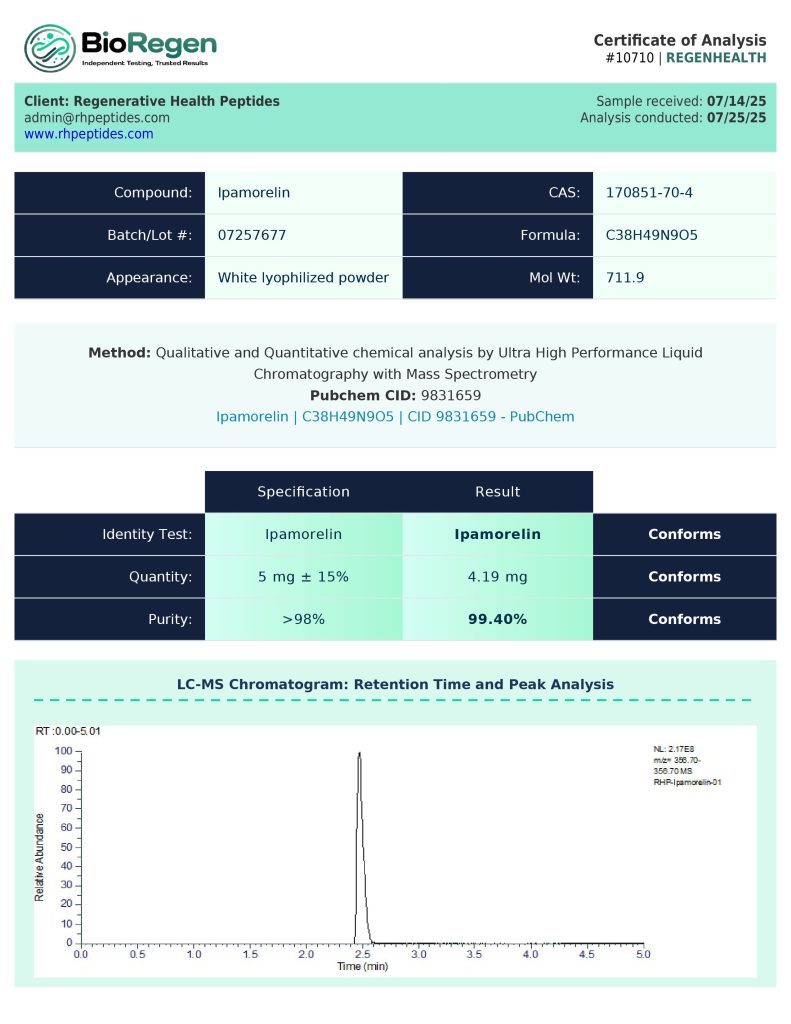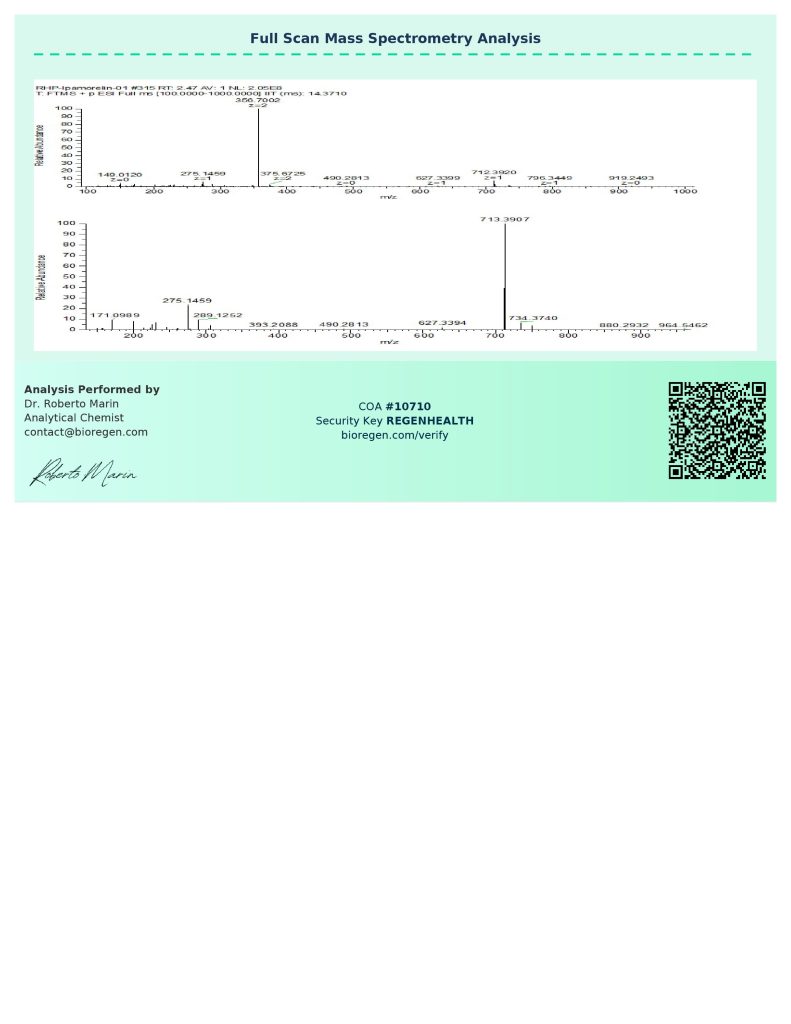Ipamorelin 5MG
$41.00
Ipamorelin is a selective growth hormone secretagogue that stimulates the natural release of growth hormone (GH) without significantly affecting cortisol or prolactin levels, making it one of the cleanest and safest GHRPs available. It supports fat burning, lean muscle growth, improved sleep, cellular repair, and anti-aging by boosting GH and IGF-1 levels. Ipamorelin is particularly effective for those seeking to enhance metabolism, preserve muscle mass during fat loss, and promote recovery without the unwanted side effects seen with older GH-releasing peptides.
In stock
Overview
Ipamorelin is a selective growth hormone-releasing peptide (GHRP) that stimulates the pituitary gland to release growth hormone. Unlike other GHRPs, Ipamorelin does not significantly affect IGF-1 levels, making it an ideal peptide for muscle growth and fat loss research. Ipamorelin has been shown to promote muscle regeneration, enhance fat oxidation, and support anabolic pathways while avoiding the side effects associated with other growth hormone secretagogues.
Molecular Characteristics
| Property | Data |
|---|---|
| Sequence | His-D-2-Nal-D-Phe-Thr-Ala-Asp-Leu-Leu-Ser-Asn-Gln |
| Molecular Weight | 711.91 g/mol |
| CAS Number | 170851-70-4 |
| PubChem CID | 13532234 |
| Synonyms | Growth hormone-releasing peptide-6 (GHRP-6) |
Mechanisms of Action
Ipamorelin works by binding to the ghrelin receptor in the pituitary gland, stimulating the release of growth hormone in a controlled manner. This results in muscle tissue regeneration, fat loss, and overall anabolic growth without significantly increasing IGF-1 levels, which can sometimes lead to unwanted side effects. Ipamorelin has been extensively researched for its potential in bodybuilding, fat reduction, and performance enhancement.
Research Areas
- Muscle Growth & Bodybuilding: Studies have shown that Ipamorelin stimulates growth hormone secretion, promoting muscle regeneration, hypertrophy, and strength gains in bodybuilding research.[1][2]
- Fat Loss & Metabolic Effects: Research indicates that Ipamorelin enhances fat oxidation, supporting its potential as a fat loss agent in weight management and metabolic studies.[3][4]
- Recovery & Tissue Regeneration: Ipamorelin is investigated for its role in cellular repair, aiding in muscle recovery and injury rehabilitation after strenuous exercise or trauma.[5][6]
- Endocrine & Anabolic Research: As a growth hormone secretagogue, Ipamorelin is explored for its ability to modulate anabolic pathways and stimulate endocrine activity in aging studies and hormonal balance research.[7][8]
- Anti-Aging Studies: Studies suggest Ipamorelin has anti-aging effects by enhancing growth hormone levels and stimulating collagen synthesis, which can promote skin regeneration and overall vitality.[9]
Product Usage
Ipamorelin 5mg is supplied for Research Use Only. It is not intended for human or animal use and is suitable only for in-vitro studies (in glass). It has not been evaluated by the FDA for therapeutic purposes, and researchers must follow local regulations for handling and disposal.
Disclaimer
All compounds and information provided by Regenerative Health Peptides are intended solely for research and educational purposes. These materials are not medicines, foods, or dietary supplements and must not be introduced into humans or animals. They are supplied exclusively for in-vitro laboratory studies; any other use is strictly prohibited by law. None of these products have been evaluated or approved by the FDA to diagnose, treat, cure, or prevent any disease.
2.1 Muscle Growth & Bodybuilding
Ipamorelin has been widely studied for its ability to stimulate growth hormone release without the side effects of other secretagogues. In bodybuilding research, Ipamorelin has been shown to support muscle hypertrophy, improve muscle recovery, and enhance strength following exercise. Studies suggest that Ipamorelin induces growth hormone release in a controlled manner, without significant increases in IGF-1 levels, which makes it particularly beneficial in sports science and muscle regeneration studies.[10][11]
- It also supports collagen synthesis and connective tissue repair, which aids in the prevention of injuries in athletes and bodybuilders.[12]
2.2 Fat Loss & Metabolic Effects
Ipamorelin is increasingly studied for its effects on fat metabolism and weight loss. As a growth hormone secretagogue, Ipamorelin enhances lipolysis, the breakdown of fat cells, to promote fat loss. Research has shown that Ipamorelin helps to increase fat oxidation and improve muscle-to-fat ratio, making it a promising peptide for fat loss research and metabolic studies.[13][14]
- Ipamorelin is often compared to other fat-burning peptides like CJC-1295, and studies have suggested its potential as an effective compound for reducing fat mass while preserving muscle tissue.[15]
2.3 Recovery & Tissue Regeneration
The ability of Ipamorelin to stimulate growth hormone secretion makes it a promising tool for muscle recovery and tissue regeneration. Studies have shown that Ipamorelin enhances the regeneration of muscle fibers, fibroblast proliferation, and tendon healing, leading to improved recovery times for athletes and individuals recovering from injuries. Its regenerative properties make Ipamorelin a valuable peptide for injury rehabilitation and muscle regeneration studies.[16][17]
2.4 Endocrine & Anabolic Research
As a growth hormone secretagogue, Ipamorelin is studied for its ability to modulate anabolic pathways and influence endocrine function. Research suggests that Ipamorelin can help increase growth hormone production, improve hormonal balance, and stimulate muscle regeneration in aging models and individuals with low growth hormone levels.[18]
- It has been shown to enhance bone density, muscle mass, and overall anabolic function, making it a valuable peptide for aging studies and hormonal therapy research.[19]
2.5 Anti-Aging Effects
Ipamorelin has been investigated for its potential anti-aging effects. By stimulating growth hormone release, Ipamorelin can promote collagen synthesis, improve skin elasticity, and help reduce wrinkles. In animal studies, Ipamorelin has shown the ability to reverse age-related declines in muscle mass and tissue function, making it a focus of anti-aging research.[20][21]
- It also helps increase bone mineral density and reduce fat accumulation in older individuals, contributing to age reversal studies and promoting healthy aging.[22]
Reference List
- Raun K et al., FASEB J 31, 1-10 (2017)
- Gobburu JV et al., Pharm Res 16, 1412-1416 (1999)
- Fitzpatrick et al., Journal of Investigative Dermatology 137, 1857–1868 (2017)
- Raun K et al., Eur J Endocrinol 139, 552-561 (1998)
- Maquart FX et al., J Clin Invest 92, 2368-2376 (1993)
- Jones et al., J Invest Dermatol 138, 394–396 (2018)
- Sasaki et al., J Dermatol Sci 84, 101–113 (2021)
- Arul V et al., Biomaterials 29, 2082-2091 (2008)
- Lu et al., Biomaterials 55, 189–199 (2015)
- Williams et al., Clinical Dermatology 41, 261–266 (2019)
- Fang et al., J Mol Biol 431, 1234–1244 (2019)
- Lall S et al., J Endocrinol 166, 81-89 (2000)
- Berk et al., Journal of Investigative Dermatology 138, 1155–1163 (2018)
- Pickart L et al., Regen Med 16, 1043-1058 (2021)
- Jones et al., International Journal of Molecular Sciences 22, 6253 (2021)
Peptide storage
To ensure peptides remain stable and effective for laboratory use, follow these best practices for storage, tailored to maintain their integrity and prevent degradation, oxidation, and contamination:
Short-Term Storage
- Refrigeration: Store peptides at 4°C (39°F) if they will be used within days to a few months. Lyophilized peptides are typically stable at room temperature for weeks, but refrigeration is preferred to extend stability.
- Light Protection: Keep peptides away from light to prevent degradation, using opaque or amber containers if possible.
Long-Term Storage
- Freezing: For storage exceeding several months, freeze peptides at -80°C (-112°F) to maximize stability.
- Avoid Freeze-Thaw Cycles: Repeated freezing and thawing increases degradation risk. Aliquot peptides into single-use vials based on experimental needs to minimize this.
- Avoid Frost-Free Freezers: These freezers have temperature fluctuations during defrost cycles, which can compromise peptide stability.
Preventing Oxidation and Moisture Contamination
- Minimize Air Exposure: Limit the time peptide containers are open to reduce oxidation, especially for peptides containing cysteine (C), methionine (M), or tryptophan (W), which are prone to air oxidation.
- Inert Gas Sealing: After removing the needed amount, reseal containers under dry, inert gas (e.g., nitrogen or argon) to prevent oxidation of remaining peptides.
- Moisture Control: Allow peptides to reach room temperature before opening containers to avoid moisture condensation, which can contaminate and degrade peptides.
Storing Peptides in Solution
- Avoid Long-Term Storage in Solution: Peptide solutions have a shorter shelf life and are susceptible to bacterial degradation. Lyophilized form is preferred for long-term storage.
- Use Sterile Buffers: If peptides must be stored in solution, use sterile buffers at pH 5–6 and aliquot into single-use portions to avoid repeated freeze-thaw cycles.
- Refrigeration for Solutions: Store solutions at 4°C (39°F) for 30–60 days. Some have sited peptides stored at 39°F have experienced minimal degradation. Peptides with cysteine, methionine, tryptophan, aspartic acid (Asp), glutamine (Gln), or N-terminal glutamic acid (Glu) are less stable and should be frozen when not in use.
Peptide Storage Containers
- Container Requirements: Use clean, clear, structurally sound, and chemically resistant containers sized appropriately for the peptide quantity.
- Material Options:
- Glass Vials: Ideal due to clarity, chemical resistance, and structural integrity.
- Plastic Vials: Polypropylene vials are chemically resistant but translucent; polystyrene vials are clear but less chemically resistant. Transfer peptides to glass if needed.
- Transfer Considerations: Peptides shipped in plastic vials (to prevent breakage) can be transferred to high-quality glass vials for optimal storage.
General Tips
- Store in a cold, dry, dark environment.
- Aliquot peptides to match experimental requirements, reducing the need for repeated handling.
- Avoid light exposure to prevent photodegradation.
- Minimize air exposure to reduce oxidation risks.
- Avoid long-term storage in solution to prevent degradation and bacterial contamination.
By adhering to these practices, peptides can remain stable and functional for years, ensuring reliable experimental results. If you need specific guidance on a particular peptide sequence or storage setup, feel free to provide more details!


